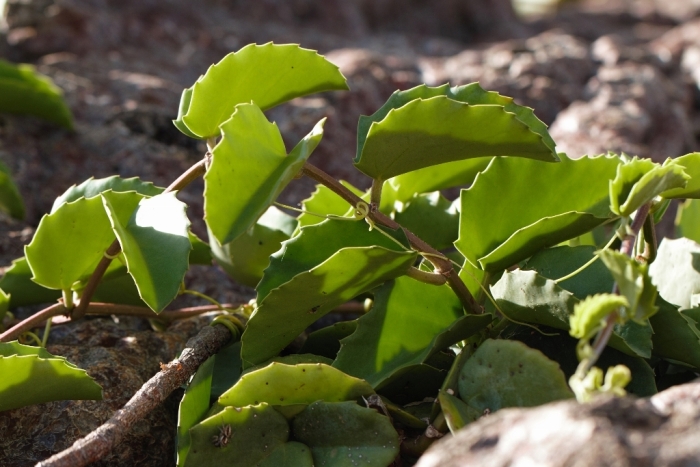Arabian Wax Leaf
(Cissus rotundifolia)
Arabian Wax Leaf (Cissus rotundifolia)
/
/

i_c_riddell
CC BY 4.0
Image By:
i_c_riddell
Recorded By:
Copyright:
CC BY 4.0
Copyright Notice:
Photo by: i_c_riddell | License Type: CC BY 4.0 | License URL: http://creativecommons.org/licenses/by/4.0/ | Rights Holder: i_c_riddell | Publisher: iNaturalist | Date Created: 2018-01-11T16:34:08-08:00 |

























Estimated Native Range
Summary
Cissus rotundifolia, commonly known as Arabian Wax Leaf, is a perennial, evergreen climber native to arid habitats and semi-desert regions in Eastern Africa and the Arabian Peninsula. It has been introduced to India, Hawaii, and the Seychelles. This vine typically grows rapidly, with thick, waxy, round leaves that are well-adapted to hot, dry climates. It can reach lengths of up to 6-8 feet (1.8-2.4 meters) when supported. The small, inconspicuous greenish-white flowers may appear throughout the year in its native range, but they are not particularly showy. The plant does not produce significant fruit or berries.
Arabian Wax Leaf is valued for its drought tolerance and is often used as a ground cover or for covering walls and trellises in hot, dry regions. It is also appreciated for its low maintenance requirements. In cultivation, it prefers well-draining soil, tolerates a range of soil types, and requires minimal water once established. It thrives in full sun to partial shade. In traditional medicine, Cissus rotundifolia is used for treating burns, skin diseases, liver, and gastrointestinal disorders. While it is generally pest-resistant, overwatering can lead to root rot. It is not known to be invasive outside its native range, but care should be taken to prevent escape in suitable climates.CC BY-SA 4.0
Arabian Wax Leaf is valued for its drought tolerance and is often used as a ground cover or for covering walls and trellises in hot, dry regions. It is also appreciated for its low maintenance requirements. In cultivation, it prefers well-draining soil, tolerates a range of soil types, and requires minimal water once established. It thrives in full sun to partial shade. In traditional medicine, Cissus rotundifolia is used for treating burns, skin diseases, liver, and gastrointestinal disorders. While it is generally pest-resistant, overwatering can lead to root rot. It is not known to be invasive outside its native range, but care should be taken to prevent escape in suitable climates.CC BY-SA 4.0
Plant Description
- Plant Type: Shrub, Vine
- Height: 1-3 feet
- Width: 2-4 feet
- Growth Rate: Slow, Moderate
- Flower Color: Green, White
- Flowering Season: Summer
- Leaf Retention: Evergreen
Growth Requirements
- Sun: Full Sun, Part Shade
- Water: Medium
- Drainage: Medium
Common Uses
Drought Tolerant, Groundcover, Low Maintenance, Potted Plant
Natural Habitat
Native to arid habitats and semi-desert regions in Eastern Africa and the Arabian Peninsula
Other Names
Common Names: Arabian Wax Leaf, Wax Grape, Venezuelan Treebine, Ukgnalo, Succulent Grape Ivy
Scientific Names: , Cissus rotundifolia, Cissus crassifolia, Cissus rotundifolia, Cissus rotundifolia var. rotundifolia, Saelanthus rotundifolius, Vitis crassifolia, Vitis forskahlii, Vitis forsskalii, Vitis pachyphylla
GBIF Accepted Name: